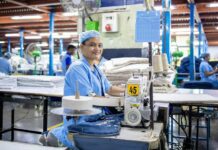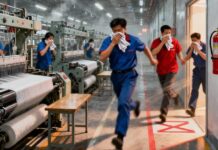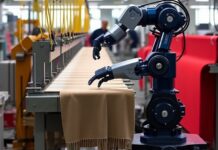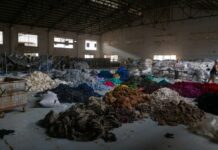In a trade environment impacted by the previous administration’s tariff strategies, the U.S. textile industry is experiencing significant repercussions, according to industry leaders. President Donald Trump had initially touted tariffs as a means to revitalize American manufacturing and bring businesses back to the U.S. However, the reality appears to be more complex.
Jeff Bowman, CEO of Cocona Labs—a company specializing in sustainable fabric solutions—expresses skepticism about the expected manufacturing resurgence. He cites historical evidence suggesting that tariffs diminish business activity rather than enhance it. “The empirical history shows that when you impose tariffs, the net effect is that you reduce the amount of business that takes place,” Bowman explained. He pointed out that rising costs ultimately burden consumers, leading to decreased sales.
Cocona Labs produces a unique compound used in high-performance fabrics but does not manufacture the fabrics themselves. Instead, the company ships its product to manufacturers globally, including those in countries affected by U.S. tariffs. As tariffs on goods increase, those countries respond with reciprocal tariffs on U.S. exports, including Cocona’s compound, which has cut into profits for the company.
Recently, Bowman faced a 16.5% tariff imposed by China on his shipments, forcing him to bear 10% of that cost. “That’s not sustainable for us,” he remarked. “Long term, we’d have to raise our prices. When we raise our prices, it will ultimately affect the volume that’s being sold. So it’s not good.”
Research confirms these sentiments, indicating that tariffs are detrimental to both domestic and global consumers, elevating prices and suppressing demand. A 2024 study by the Federal Reserve Board found that tariffs imposed during Trump’s first term led to retaliatory taxes on U.S. goods, negatively affecting demand.
Meanwhile, promises of a manufacturing boom have largely gone unfulfilled, particularly in the textile sector, which has seen dramatic workforce reductions. According to the New York Times, this sector employs only a fraction of the 1.5 million individuals it once did. Moreover, the overall manufacturing sector has contracted during Trump’s second term. The Institute for Supply Management reported that U.S. manufacturing faced declines for the fifth consecutive month in July, with employment also shrinking for six straight months.
Amid these challenges, few companies are willing to invest in domestic production given the unpredictable tariff landscape. Although some firms, like Apple, are committing to U.S.-based manufacturing, the majority remain hesitant, stymied by an uncertain economic environment. Economist Robert Lawrence commented on this trend, saying that current industrial and trade policies seem to be driven by nostalgia for a bygone era of manufacturing that is unlikely to return.
As the textile industry navigates these hurdles, the fallout from tariffs continues to challenge its viability, prompting concerns about the future of American manufacturing.


































